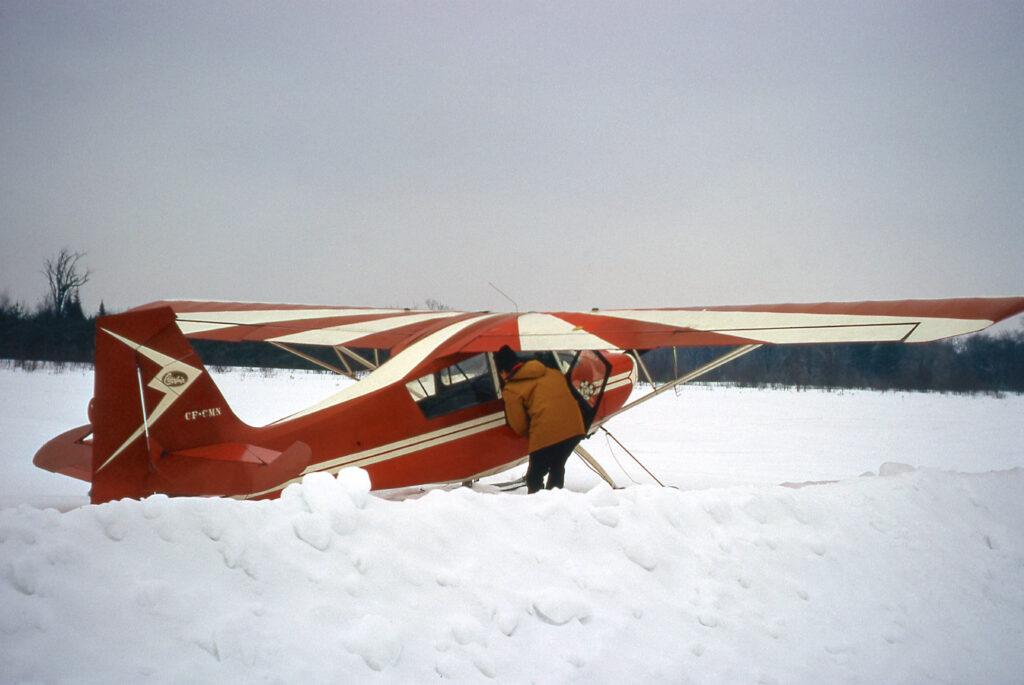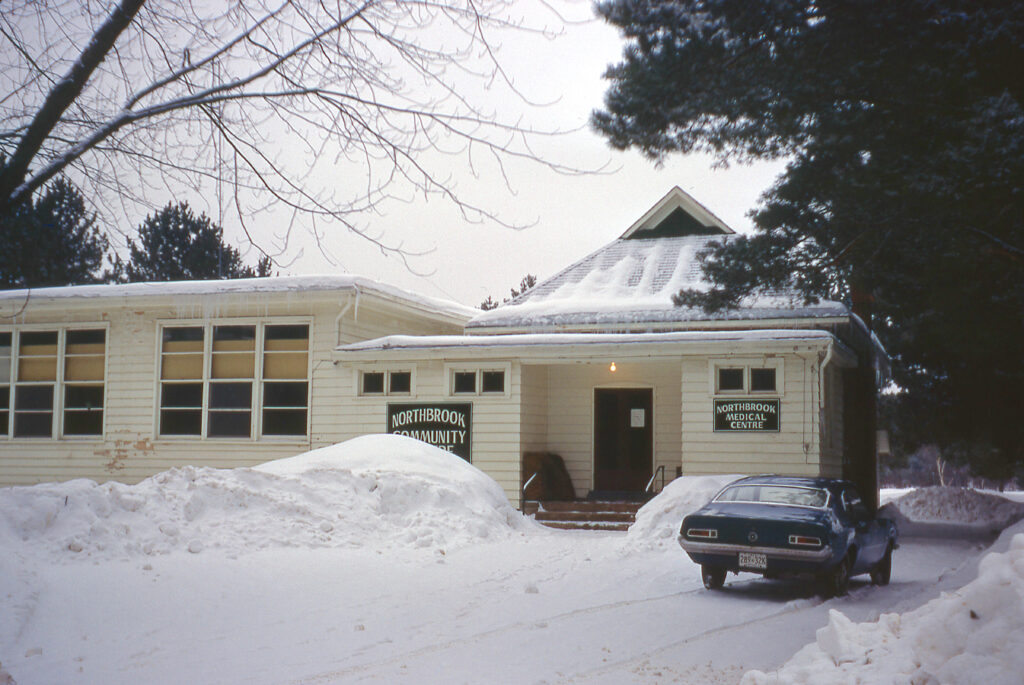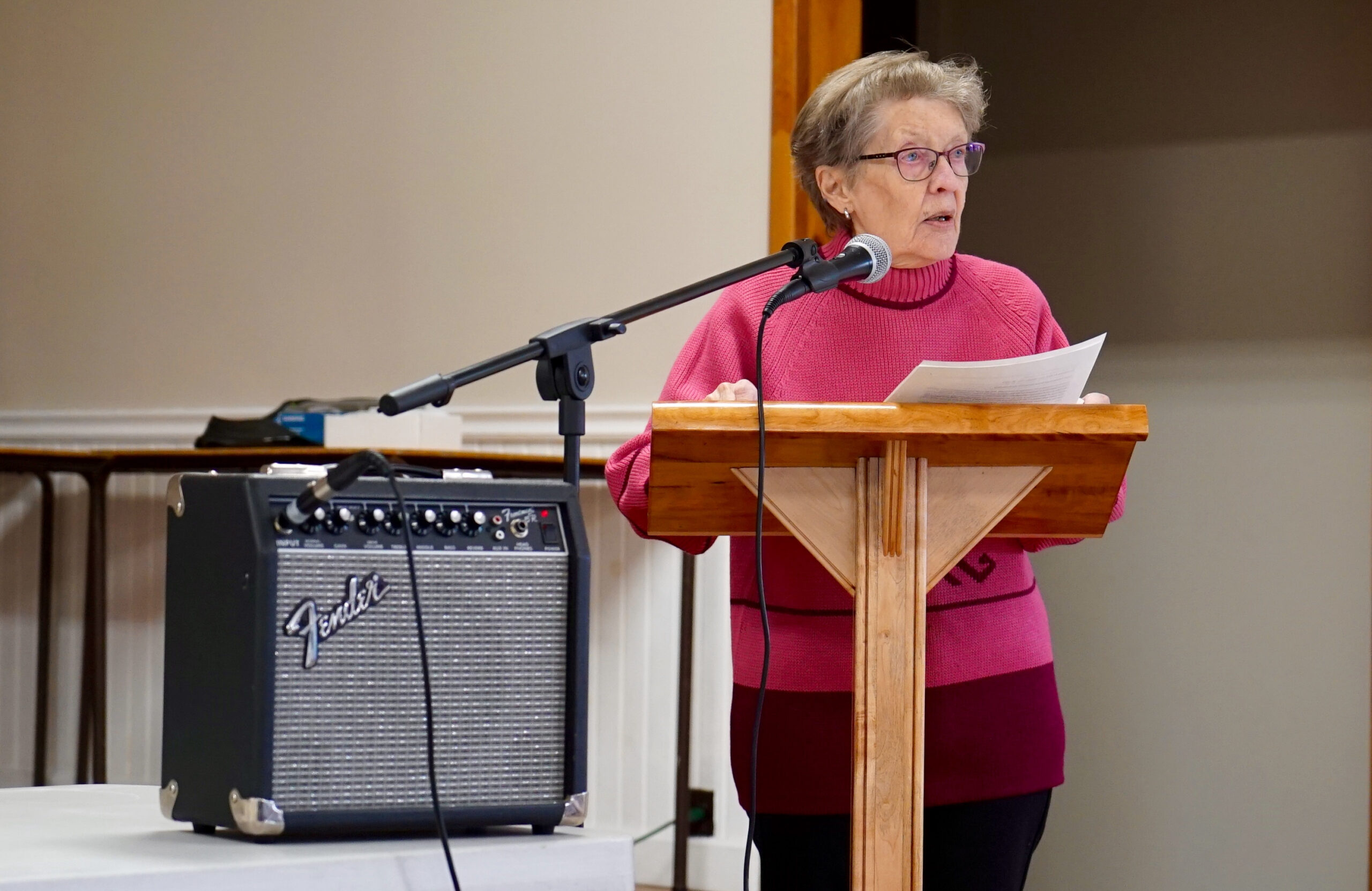History of Getting Those Services Here:
Before the 1970s, there were basically no medical facilities here. Volunteers were trained through an emergency organization to do first response treatments at accident sites, for example. Doctors were available for a time three days a week, Monday., Wednesday., Friday. They flew in from Kingston, one at a time, not all three at once, landing at the airstrip which now is beside Pine Meadow Nursing Home. The personnel changed, so that as a patient you never knew the doctor you were getting. Particularly hard on older people, who didn’t want to have to keep telling a new doctor about their symptoms every time they saw one.

A Flying Doctor Arrives in Northbrook – 1972. Photo by Dr. Richard Milne.
In 1971. a “get a doctor” committee was formed. Proposals were sent to the Physicians Services Incorporation Foundation. Finally a need was recognized outside of the immediate area and a donation of $68,000 over 3 years was made.to help fund the work of this committee. Progress had begun. Dr. Richard Milne was the first doctor in the area, with Nurse Practitioner Tish Butson and receptionist Helen Yanch rounding out the team.
In 1976, Land o’ Lakes Community Services was incorporated. Its mandate was “to provide medical, dental, pharmaceutical, social and extended health care by qualified people for persons in the catchment area”. Finally there was an official structure to which social, mental and medical concerns could be referred.
In June of 1979. a medical centre 40′ x 60′ was constructed in Northbrook. The system of temporary doctors continued until 1984, when Dr. Tobia was hired. He moved to the area with his family, with seemingly an intention to stay, so local people were somewhat assured by that.

Former Northbrook Medical Centre – 1972. Photo by Dr. Richard Milne.
Funding from the Ministry of Community and Social Services provided money for 100 seniors to travel out to Belleville, Renfrew, Kingston, Eganville and Pembroke, thus allowing seniors to go out for doctors appointments and specialized medical treatments. That bus schedule is, I believe, still operating.
In the 60s and 70s, many doctors had come and gone, until Dr Tobia’s arrival in 1984.
After this several new programs were begun.
During this time period, a retired social worker began to talk to people about what their living conditions were like. This was Isobel Stewart, who had moved to the area from Toronto. Her insights were valuable, her methods somewhat unusual. She would pick a road, drive to the end of it, get out and start knocking on doors. She would talk to people there about what they were doing in their lives. Many had family who had been raised in the area but had moved away, returning home once or twice a year. This situation often led to more elderly people being lonely and not having any means to pick up medications or even small items from which they might get comfort. So a visit from a social worker, even if she were a stranger, would have been welcome. Although never formally recognized by the system, Isobel was an important person in the field.
…1983 – a Social Worker and Adult Protective Services worker were hired.
…The Safe Homes Program was begun, allowing a refuge for women experiencing spousal abuse.
…1986 – a Human Resources Coordinator was hired to provide Community Mental Health services on a weekly basis
…community palliative care program was established.
Over the years, various executive directors were hired to supervise these programs, and report progress to the Board. Nancy Cannon and Margaret Schwager. two names you might recognize.
Some of the additional programs established for the benefit of the community: Christmas Exchange Program designed to help out needy families, Breakfast with Santa, Safe Homes, Meals on Wheels and lots more.
Creating a Long Term Care Facility
Time now to move the focus to a Long Term Care Facility. A study had been done by various seniors groups in 1982. Eventually, permission was granted by the Ministry of Health in 1988 for a 60 bed nursing home in Northbrook. Between 1982 and 1988, various presentations were made to various individuals from the Ministry of Health, some more welcoming than others. two personal reflections here – the black-suited man from the Ministry who told us, in Northbrook – “you will never have a nursing home here”, and the actions of an official in the Ministry of Health office in Toronto, who moved our application from midway down the pile to the top! In 1992, a Management Contract with Extendicare Canada was signed. This allowed what was essentially a “rookie” committee to take advantage of their expertise in both handling government and in their buying power. Approximately two months later, we had our approval and work began.
The objective was to raise 1.2 million dollars over five years. The designs had been approved in 1990. The home was named by Colleen Hayes, then a Grade 6 student at NAEC who happened to live almost next door to where the facility would be built in Northbrook. A committee of eight was appointed to oversee the operations of Pine Meadow and report to LOLCS, headed by an old friend, Vera Abbott, who now lives in Simcoe, but used to live on Mazinaw Lake.
The first resident was Colbert Lessard of Flinton. The same day, Geraldine Pickett of Arden and Ann Perry of Northbrook were admitted. Colbert and Ann were brother and sister, and apparently some rivalry existed between the two of them about who would be the first resident of the home. Colbert beat Ann, but only because she had to come from Marmora to register. They ended up, of course, sharing the honour of being the first residents of PMNH.
Three months later, all 60 beds had been filled. Approximately 60 people, very many of them local had been hired for jobs both inside and outside this new building.
Since 1988, changes have been made to programs and to staff, but the level of care remains the same – excellent, consistent, friendly, any positive words you might be tempted to use. The current administrator is Margaret Palimaka, who is looked upon with great respect both inside the home and in her association within the larger community.
Many activities for people to do, many folks in and out to provide community connections to the home. It has become such an advantage to our community and hopefully will continue to be for a very long time.
The whole social services “industry”, if it can be called that, has from the beginning, been dependent on volunteers. These were, and still are, people who care about the welfare of their community and are willing to put their spare time into doing what they can to help. We are fortunate to have people like this among us. Our community is so much richer because of them.
Margaret Axford, November 20, 2023


0 Comments